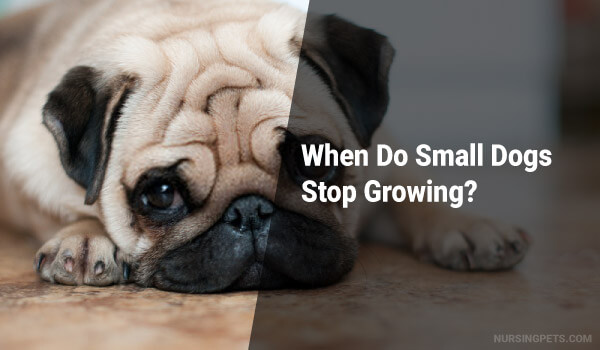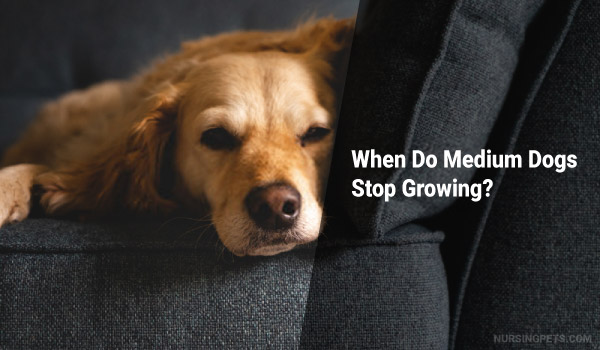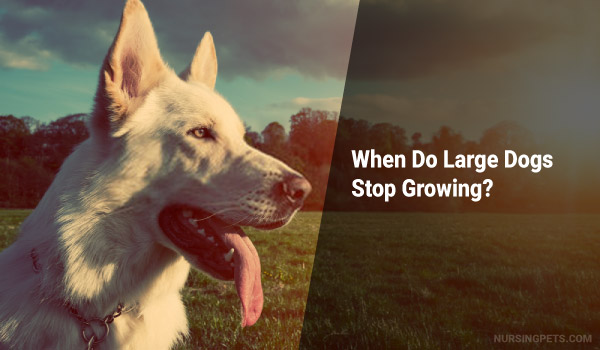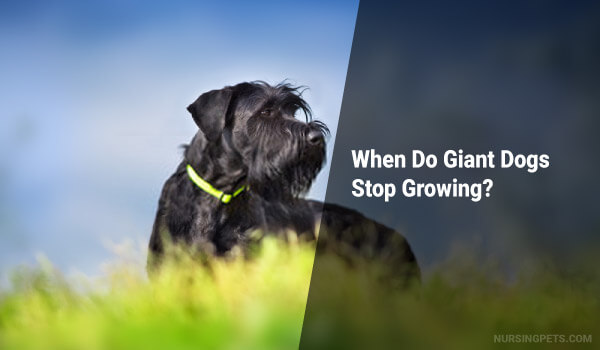When Are Dogs Full-Grown? Calculate Yourself
Today’s topic is “When are dogs full grown?” I don’t know about you guys; every time I saw a big pup or dog, the first thing that comes into my mind- is that all he/she got! If not, how much more will it grow?
Ever wondered when your puppy is a full grown-up? This is one of the most common curiosities among pet owners.
DR. MEG WALKER, a certified professional vet, says- “At every new puppy appointment, people always ask the question, how fast their pups will grow and when they will stop growing,”
It assumes that the first year of your dog’s life is equal to about 15 human years. They mature faster than we humans do early on.
When are dogs full-grown? The answer to this question is not a straight-cut one. It depends on several things like- breed type, genetics, etc.
So, how can you understand that, whether your dog is full grown-ups or there are more to come? How big will they get in the end? How much exercise does a dog need every day? When does a dog stop growing? How do I feed a growing puppy?
See? There is too much to know about your pup. Don’t worry; we will discuss all these questions and more in this article. So, let’s get started without any ado.
When Do Dogs Stop Growing?
“Genetics is the number one factor that affects growth rate,” says Dr. Walker. “We may guess, based on the breed, but there are more factors that determine it, such as parents. The idea that a puppy’s paws will determine their size is a myth,” explains Dr. Walker.
Male dogs tend to be bigger than female ones. So, gender also plays a role in the growth factor of a puppy.
Neutering at early age cancels out chemicals that stop the growth at some point. Thus, early neutering also can cause long bones.
Although puppies become adults while they are somewhat about 1 year old, they continue their growth in the muscle and fat, even while their bones are developing, which may need a total of 6 months to 2 years.
Skeletal growth is also an important one. It determines how tall dogs will become as they reach their adulthood.
Most of the vets are agree on the fact that- Dog Breeds play a major role in a canine’s final growth size and time to reach that growth.
Based on the dogs’ breed, there are four types of dogs:
- Toy/Small
- Medium
- Large
- Giant
The global governing body of dog breeds is the Fédération Cynologique Internationale (FCI), or the World Canine Organization. They recognize over 340 dog breeds throughout the world.
The American Kennel Club (AKC), a trusted expert in breed, has recognized 193 dog breeds only. Below are some average ages for the maturation of different breed sizes.
When Do Small Dogs Stop Growing?

Smaller breeds are less than 25 pounds dogs at their full grown-ups. Small pups grow up pretty fast. They tend to reach their final growth stage between 06-08 months old. In general, they should fill out their weight by 12 months or a year.
Popular Smaller Dogs Breed: (Read This Book About Dogs Breed)
- Dachshund
- Maltese
- Yorkshire Terrier
- Toy Poodle
- Chihuahua
- Bichon Frisé
- Chihuahuas
- Pomeranians
- Affenpinschers
- Teacup Maltese
- Pugs
- Papillons
- Chinese Cresteds
- Shih Tzu
- Toy Fox Terriers
- Cavalier King Charles Spaniels
- Mini Cockapoos
- Brussels Griffons
- Pekingese
- Miniature Pinschers
When Do Medium Dogs Stop Growing?

Medium breed dogs are between 25 to 50 pounds when they are all grown-up. When they become somewhere about 12 months or 8 to 12 weeks old, the dogs reach their adulthood. Some medium breeds can grow even after that time too.
Popular Medium-Sized Dogs:
- Brittany
- Border Collie
- Whippet
- Poodle
- Shetland Sheepdog
- Labrador Retriever
- Wheaten Terriers
- Welsh Corgi
- Bearded Collies
- Bulldogs
- English Springer Spaniels
- Nova Scotia Duck Tolling Retriever
- Portuguese Water Dogs
- Cocker Spaniel
- English Foxhound
- American Foxhound
- Australian Cattle
- Australian Shepherd
- Basenji
- Beagle
- English Springer Spaniel
- German Shorthaired Pointer
- Basset Hound
- Siberian Husky
- French Bulldog
- Viszla
When Do Large Dogs Stop Growing?

Large breed pups usually weigh between 50 and 100 pounds as adults. A large dog usually takes more time to reach its full growth because its bigger bones require more time to develop. Larger breed puppies won’t reach their final physique before 15 to 18 months.
Large Breeds Of Dog:
- Afghan Hound
- Airedale Terrier
- Akita
- Alaskan Malamute
- American English Coonhound
- American Foxhound
- Bearded Collie
- Beauceron
- Borzoi
- American Staffordshire Terrier
- Samoyed
- Belgian Sheepdog
- Belgian Tervuren
- Black Russian Terrier
- Bloodhound
- Boxer
- Bracco Italiano
- Hanoverian Hound
- Hovawart
- Komondor
- Kuvasz
- Mastiff
When Do Giant Dogs Stop Growing?

Giant breed dogs take the longest time to grow, due to their large skeletal frame in their body.
They will be at their full potential growth by 18 to 24 months, may take up to three years to arrive at their full weight. They could seem lanky until then.
Giant Breed Dogs:
- Bullmastiff
- Collie
- Anatolian Shepard Dog
- Newfoundland
- The Great Dane
- Cane Corso
- Scottish Deerhound
- Mastiff
- Leonberger
- Saint Bernard
- Dogue de Bordeaux
- The Great Pyrenees
- Irish Wolfhound
- Neapolitan Mastiff
If interested in the details of dog breeds, you can look into this article in Wiki – List of dog breeds. Also, the list of dog cross-breeds.
How Can You Predict Your Puppy’s Size?
Except looking into your pup’s breed, there is a calculative way you can tell “when are dogs full grown.” How you do it?
Toy and Small breeds: To calculate their final, you have to wait until 06 weeks of age. Now, double the current weight two times.
For example, a 01-pound pup at six weeks old will weigh around 04 pounds as an adult.
Medium and Large Breeds: Wait until your pup becomes around 14 weeks of age. Here you have to double the 14 weeks weight and then add half of the current weight to find the adult weight.
For example, a 25 pounds pup at 14 weeks old is predicted to weigh 25+25+12.5 = Total 62.5 pounds.
Another Way To Find Out The Adult Size
There is another way you can predict your pup’s final weight. The formula for this calculation is like this-
- Small Breeds weight at 12 weeks
- Medium Breeds weight at 16 weeks
- Large Breeds weight at 20 weeks
Receive the puppy’s weight in lbs./pounds (at a particular age given above) and divide it by age in weeks of the puppy. Then, multiply the figure by 52 (Why 52? It’s because this is the total number of weeks in a year).
Suppose, a medium-sized dog weighs 10 pounds at 16 weeks. How you calculate this one’s adult weight:
10 (lbs.) / 16 Weeks (10 divided 16) is equal to 0.625
0.625 * 52 = 32.5 pounds, predicted adult weight.
If it seems too complicated for you guys, you can always check on Puppy Weight Calculator.
The best way to know your adult puppy size- visit your nearest pet center. Some professionals can tell you, “When are Dogs Full Grown.”
How Heavy Should My Dog Be?
There are lots of things which may cause the weight to vary from one pup to another. There is a chart given by the professionals about a puppy’s growth. From here, you can assume whether your pup is in perfect condition or not.
Puppies Growth Chart:
| PUPPY GROWTH CHART | ||||||
|---|---|---|---|---|---|---|
| Dog Breed Size | ||||||
| Dog Age In Months |
Toy | Small | Medium | Large | Giant | |
| 0 | 6 oz | 8 oz | 10 oz | 1 lb | 1 lb 8 oz | |
| 2 | 2 lb 4 oz | 3 lbs | 7 lbs | 18 lbs | 22 lbs | |
| 4 | 4 lb 2 oz | 9 lbs | 21 lbs | 38 lbs | 55 lbs | |
| 6 | 5 lb 8 oz | 13 lbs | 30 lbs | 55 lbs | 85 lbs | |
| 8 | 6 lb 8 oz | 15 lbs | 35 lbs | 62 lbs | 100 lbs | |
| 12 | 17 lbs | 38 lbs | 70 lbs | 130 lbs | ||
| 18 | 75 lbs | 145 lbs | ||||
| 24 | 150 lbs | |||||
Signs Of An Underweight Dog
So, how can you tell if your pup is underweight? There are some things you will see in a healthy puppy. If they don’t match, then your pup may be underweight.
Signs Of A Healthy Puppy
No Visible Ribs:
After crossing the six months of age, you shouldn’t be able to see ribs of your puppy. It may differ a little among racing breeds, but no more than 2/3 ribs.
Feeling the Ribs:
Ribs should be covered with a soft layer of fat. Still, you should be able to feel them while running down your hands on the puppy’s sides.
The Waist of a Pup:
Look at your pup before his jump and rump. You should be able to see the Waist from the sides.
Tuck of a pup:
Looking from the side, the pup’s tummy should tilt up. That is it highest before vanishing within back legs.
If you can’t find these signs in your pup and can feel the knobbles on his spin, your pup is too thin.
How Do I Feed A Growing Puppy?
The best way to keep your dog healthy is to follow the nutritional guidelines given by the professional vet. Some foods can be fed at all stages, especially both growing and adult ones.
Also, there are puppy- specific foods that assure the nutrition of your pup.
Always try to follow the feeding guidelines of your pup so that your pup won’t be underweight or overweight.
How Much Exercise Does A Dog Need Every Day?
The question should be like, “Exercises a dog really need for every day?”
The required amount of exercise a dog needs, rely on some factors, like dog breeds, lifetime, size, and health, etc.
If you own a dog, you should exercise her from 30 to 2 hours every day. This is the suggestion from the professionals.
Bullmastiff, Collie, Retrievers, shepherds, and breeds like them need more exercise than the smaller ones. Breeds, like terriers, Maltese’s, and others, don’t need exercise that much.
When Does A Dog Stop Growing?
Rather you could say, what causes a pup to stop growing? There could be some situations when your pup is not growing at a normal rate according to his age.
This called “stunning growth.” There are reasons, like- worm infection, which may cause stunted growth in dogs.
The common cause of why a pup’s growth development becomes stunted. Infected by hookworms or roundworms/ Nematode. In the United States, Intestinal worms are usual among puppies. A canine who has heavy worm infestation, the worms can steal calories from the pup to slow down growth.
F. A. Q (Frequently Asked Questions)
1. What To Expect After A Neutering Dog?
What can you expect after neutering or spaying your dog? According to ASPCA’s (American Society for the Prevention of Cruelty to Animals) –
After neutering a female pet, she will live a longer and healthier life than before.
Neutering a male pup prevents testicular cancer and some prostate problems. Neutering or spaying can also help with some behavioral issues of the pup.
Neutering doesn’t stunt the growth of a pup. Rather, it could affect the joints of a large breed.
Sometimes, early neutering causes growing more than usual. Which is for neutering removes some chemicals which prevent them from growing more.
2. When Are Dogs Neutered?
So, when should be the best time to neuter a puppy? Normally, people neuter their pups between 06 to 09 months. If your pups are healthy enough, you can neuter them as 08 weeks old.
3. Dogs’ Years In Human Years?
You may have heard this somewhere that: One year for Fido is like Seven years for you.
It turns out, and the math isn’t like this. Pups grow faster than we do early on. So, it is said that the first year of your pups’ life is equal to about 15 human years.
Winding-Up
To find out your pups’ adult size and weight, you can use the methods we discussed above. But the best way is to visit your nearest pup center and talk with a professional vet and prepare yourself for the changes required on growth time.
You and I both know; the final size of our beloved pup isn’t something that will bother us. No matter what, our love for them won’t decrease.
Well, the pup parents, this is all our discussion for today. Don’t wanna brag anymore.
Tell us about your pup’s growth in the comment section. And, what’s the predicted adult weight of your pup?

